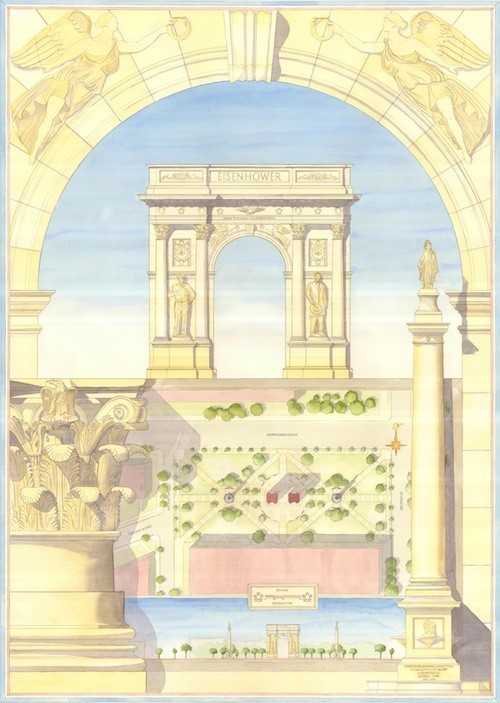
WASHINGTON -- There is a long tradition, dating back to the founding of this city, of landmarks being constructed here during difficult times. The dome of the United States Capitol was built during the Civil War, and the Jefferson Memorial was doubly difficult to finish: The project began during the Great Depression and was completed during World War II.
Now the planners of the Dwight D. Eisenhower Memorial find themselves in a bind as well. Just as they are set to make a final case to Congress for the funds needed to construct the Frank Gehry-designed memorial, opponents of the plan are proposing alternative schemes and asking questions about how Gehry was selected for the commission in the first place. And that's to say nothing of the challenge of seeking tens of millions of dollars of funding at a time when politicians are fighting over how many trillions of dollars of debt the country can continue to assume.
The Gehry design itself is still a work in progress, and it is as much a work of landscape architecture as it is of architecture. The four-acre site between the National Air and Space Museum and the Department of Education -- both of which Eisenhower helped create during his two terms as president -- is to be surrounded by woven-metal tapestries and covered by sycamore trees, grass and stone blocks. The stones will chronicle Eisenhower's work as a general and president; the tapestries, which will be transparent enough to preserve views from the Education Department's headquarters, will feature images central to Eisenhower's childhood and life.
"Different people like different things," said Daniel Feil, the executive architect at the Dwight D. Eisenhower Memorial Commission. "But this is a design that is quite an extraordinary remembrance of President Eisenhower, and that will transform this plot of land."
Others in Washington, though, still hope President Eisenhower's memorial will be more traditional. This past spring, the National Civic Art Society, led by chairman Eric Wind, invited classical architects to submit alternatives designs for the Eisenhower memorial. The winning counter-proposal, designed by Daniel Cook, a graduate of the architecture program at the University of Notre Dame, separates images of Eisenhower as general and of him as president with a large arch. "Peace Through Understanding" is inscribed between the images, and two large columns set in fountains stand to the side of the major structure.
"Some people will say these projects are not important. Some people will say no public money should be spent on these works," said Wind. "Our argument is that if you have good, timeless designs you can get public support and these monuments can be funded primarily through private donations rather than public taxpayer dollars."

The winning plan from the National Civic Art Society's competition, designed by Daniel Cook. (National Civic Art Society)
Wind, whose competition has been praised in the Providence Journal and elsewhere, is now trying to focus wider scrutiny on the funding for the Gehry proposal. He is planning to submit a Freedom of Information Act request seeking documents from the Eisenhower Memorial Commission soon and will also bring the matter to the attention of Senators Joe Lieberman (I - Conn.) and Susan Collins (R - Maine), and Representatives Darrell Issa (R-Calif.) and Elijah Cummings (D-Md.), who chair the committees that oversee the U.S. General Services Administration, which ran the original design competition.
The question is how the $16 million allocated by the government for both the competition that led to the selection of Gehry design and the design itself has been spent so far, and whether the competition was ever truly competitive. Wind noted that his classical competition cost just $2,000, but the process it used was quite different from the government's.
"We want further explanation as to how they spent the money they have been allocated by Congress," Wind told The Huffington Post. "We also are curious to see their interactions and correspondence with Gehry Partners both before the competition and after, but especially before." Wind said the National Civic Art Society hopes to find evidence that shows Gehry was always the favored candidate for the project. But for now, he won't say publicly whether his organization has any evidence to back up that claim.
Feil said the Eisenhower Memorial Commission followed the protocols of the GSA's Design Excellence Program, and that both an evaluation panel and a design jury -- both of which included independent experts -- reviewed seven proposals before selecting Gehry's firm for the work. In total, the project will cost well over $100 million, with 80 percent to come from the government. Fundraisers are aiming to raise $35 million from private sources.
For her part, Susan Eisenhower, the president's granddaughter, raised some concerns at the unveiling of Cook's alternate plan. While she was quick to make clear that she was speaking only for herself, she said she was struck by "how complicated people have made" the design of the memorial.
"It's really not that complicated," she went on, praising the entrants in the National Civic Art Society's contest. "I see so many wonderful examples of how things can be boiled down into their elegant simplicity here."
She said it was the "timeless" approach of the Lincoln and Washington memorials that designers should keep in mind. But Feil stood behind the Gehry design, even as he said Cook's plan was "just as a drawing, really quite remarkable."
"The neoclassical ideas they have, it's just another approach," added Feil. "There's no right or wrong way. But we went this way."
If all goes to plan, Feil said, construction will begin toward the end of 2012 and finish in time for an opening in 2015 on Memorial Day.